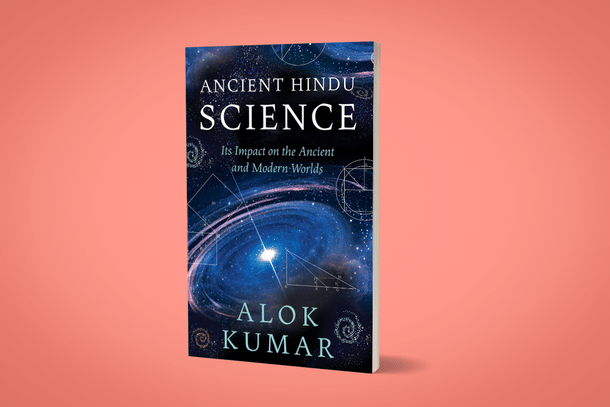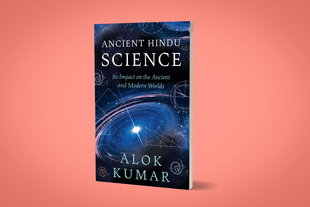Science
A Glimpse Of What History Of Science Would Look Like If It Wasn't Averse To The 'H' Word
Aravindan Neelakandan
Jan 25, 2022, 01:32 PM | Updated 01:32 PM IST
Save & read from anywhere!
Bookmark stories for easy access on any device or the Swarajya app.


Ancient Hindu Science: Its Impact On The Ancient And Modern World. Alok Kumar. Jaico Publication House. Pages 212. Rs 410.
There is a renewed interest in the non-Eurocentric historiography of science these days. Science historian Joseph Needham brought the focus on the contribution of the Chinese civilisation to the process and the global institution we call science today. There have been studies which have brought out the native American and African contributions to science too.
However, the ancient Chinese civilisation is no more a living civilisation. It is now a Marxist-Maoist society that has been uprooted from its Taoist-Buddhist substratum. In fact, the Communist Party of China passed a resolution in 1927 that China was no longer an Asian nation.
African spiritual traditions exist in periphery and are often demonised in popular culture.
Native Americans are no longer a civilisational alternative to the dominant Western civilisation.
India, on the other hand, is a living nation still attached to its civilisational roots, despite centuries of aggressive challenges. So, presenting the contribution of India, and hence Hindus, to the sciences is problematic unless it is presented as a kind of museum exhibit. India can be presented as ‘wonder that was’ but not as a living continuity. In fact, there is a particular aversion to the 'H' word – Hindu.
Prof Alok Kumar faces this bias and records this in the introduction itself:
After I was done with the manuscript of one of my previous books, Sciences of the Ancient Hindus: Unlocking Nature in the Pursuit of Salvation, I submitted it to an internationally renowned publisher. After about two years of review process, the publisher agreed to publish the book provided I drop the term Hindus from the title and replace with Indian. One reviewer warned me of ‘‘the deeply contested nature of the adjective Hindu and its association with a particular kind of nationalist politics” in India. This was prior to Narendra Modi’s government in India. I have no involvement in Indian politics now nor I ever had one at any stage. I have lived most of my adult life in America. I rejected the suggestion since I wanted to be truthful.Kumar, Alok. Ancient Hindu Science (pp. 11-12). Kindle Edition.
Professor Kumar is a physicist, teaching at SUNY Oswego and his book on ancient Hindu science is important for both the students of Indian culture and students of the history of science.
The chapter ‘Building Blocks of Science’ brings together two important aspects of the Hindu worldview: inner happiness and the quest for truth. These two intersect at a vital point. Hindus understood that. Writes the professor of physics:
The natural philosophy of Hindus fulfills the spiritual needs of people as well as their need for rational thinking. It is for this reason that Ārybhaṭa I, in his book Āryabhaṭīya, covering astronomy, mathematics, and physics, suggested that one can achieve Brahman by becoming well versed in the disciplines of astronomy, physics, and mathematics. Similarly, Kaṇāda, in his book Vaiśeṣika-sūtra, defined the physical properties of matter and suggested that the knowledge is helpful in achieving mokṣa. Also, the Agni-Purāṇa suggests that knowledge of the human anatomy can also lead to mokṣa.(pp. 39-40)
Very aptly the author draws the parallel between this Hindu core value and the celebrated statement of Einstein:
I maintain that the cosmic religious feeling is the strongest and noblest motive for scientific research. Thus, science became a tool to learn about the God… in this materialistic age of ours the serious scientific workers are the only profoundly religious people.(p. 40)
The importance of this book should be understood by the reader both in its intrinsic value and also in the larger context of the battle for narratives. For example, I had the misfortune of reading the following line in a book, published by a very prestigious publishing house, regarding the discovery of zero:
Quite ironically, the discovery of zero is attributed to Aryabhatta. If Aryabhatta discovered zero in the fifth century, was there no counting beyond ten before him? The shepherds had to count their cattle, sheep and goats every day! Thus, the science of counting that was developed by the productive masses must have been appropriated by the Brahmanic writers.Kancha Illaiah, Post-Hindu India, Sage Publications, 2009, p.117
The reader should forgive the reviewer for moving from sublime to obscenely ridiculous but the above passage was written by an academic who is regularly quoted by historians of a particular dominant school in India and the academic also regularly graces TV debates when he is not giving testimony against India in the human rights commissions in the United States. This is the standard of the discourse of science historiography with respect to ancient India.
Now read what Prof Alok Kumar writes:
Zero is a numeral and it has the same status as any other numerals, all in the absence of any magnitude. The presence of zero indicates a specific absence of the symbols of 1, 2, … , 9 at that location. Zero is thus a sign that defines no value or a missing value in a particular location in a number. Zero plays the role of a number and at the same time signifies the metaphysical reality of the absence of substance (emptiness). In Hindu philosophy, the terms śunyata and neti-neti define emptiness which evolved into a mathematical reality in the form of zero, as explained later. Zero, as a “void,” is an integral part of the Hindu philosophy. The nirguṇa-rūpa (nonmanifested-form, amūrta-rūpa) of God is worshiped by the Hindus.Kumar, Alok. Ancient Hindu Science, (p. 71)
One can now understand the value and importance of the book in the larger context of narrative building as also in terms of its intrinsic worth.
The chapter on mathematics also has a section on how Indian ideas travelled to Europe and fertilised the mathematical conceptions of late medieval Christendom. Thus, Hindu contribution to the Enlightenment era in Europe, particularly in terms of core mathematical ideas, from the Hindu numerals to the Madhava series of Kerala mathematicians, is a subject which should be studied by historians and highlighted in our history textbooks.
In the chapter on astronomy again the book brings out a stimulating picture. The way Hindu astronomers combine beautiful poetic examples with their discoveries is worth studying by modern popular science writers:
Āryabhaṭa I used an analogy of a kadamba flower (neolamarckia cadamba) (Figure 4.1) to demonstrate the distribution of various life forms on the Earth: “… Just as the ball formed by a kadamba flower is surrounded on all sides by blossoms just so the Earth is surrounded on all sides by all creatures terrestrial and aquatic.”(p. 125)
Instead of giving interpretations from the advantage of hindsight, the author gives proof of the claims through the statements of non-Indian scholars like Strabo and Al-Biruni. This is quite important. In the chapter on physics also, it is on the authority of Al-Biruni that the author notes the following:
Al-Bīrūnī claims that “the educated Hindus determine the daily phases of the tides by the rising and setting of the Moon, the monthly phases by the increase and waning of the Moon …” Johannes Kepler (1571–1630 CE) is generally credited with suggesting the correlation of ocean tides with the phases of the Moon. Kepler lived about five centuries after Al-Bīrūnī and more than at least a millennium after the Viṣṇu-Purāṇa was written.(p. 188)
The chapter on biology needs some attention here. Hindus are as a people quite comfortable with evolution. Pew Surveys often point out this fact that Hindus and Buddhists are the largest religious groups which do not find evolution uncomfortable. At the same time the author notes an important point that ‘the ancient Hindus systematically studied various life forms and noticed inter-dependencies and commonness in them’ (p. 218).
Though Hindus had a strong conceptual notion of natural evolution because of the Sankhya Darshana, the book is silent on this vital subject.
The book discusses the work of Acharya J C Bose in detail. The concept of plant-soul was part of pre-Christian Western philosophy also and it kind of existed in the peripheral memories of the Western thought even during medieval and late medieval Christendom. However, it was Charles Darwin who, along with his son Francis Darwin, who came with what was then (and perhaps even now) an audacious hypothesis – the root-brain hypothesis.
Bose, while as a student in England, definitely came in contact with Francis Darwin as his teacher. While the British physiologists and botanists were having mental blocs in exploring the cognitive abilities of the plants as forming a continuum with the mental life we see in animal kingdom, Bose had no such mental inhibitions. Vedanta provided him with the sense of unity and Darwinian science reinforced the Vedantic vision.
Bose in fact openly expressed this Vedantic vision of non-duality. This then is the importance of Bose. One can be sure the later editions of the book will have added chapters/sections on evolution and ecology.
The book also deals with the global impact of the natural philosophical conceptions of Hindus. The chapter has two sections. One deals with the ancient period and the other with the modern period. The latter again has two sections – one dealing with the transcendental movement and the other deals with the impact on the modern physics. The emphasis is on Erwin Schrodinger. And rightly so.
The book ends with an emotional plea to the reader:
This book is written to preserve the knowledge of the ancient Hindus and to recognize their rightful place in world history. … The twenty-first century is the harbinger of free, open and honest pursuit of scientific knowledge in all its varied dimensions unfettered by dogma or national or cultural chauvinism.(p. 298)
This is indeed as significant as rest of the book and carries a vital message for young students of history of science and also educators. The understanding as well as highlighting of Hindu contribution is important because it is a constructive and corrective measure. It is not a means to claim cultural superiority. Nor it is a claim of religious chauvinism. Instead this will make science a more universal inclusive human endeavour that belongs to all humanity.
Aravindan is a contributing editor at Swarajya.





